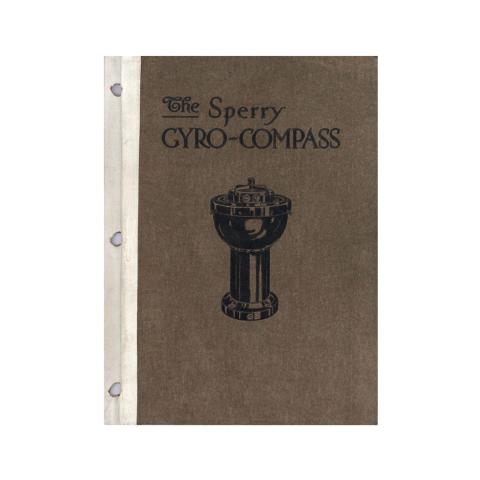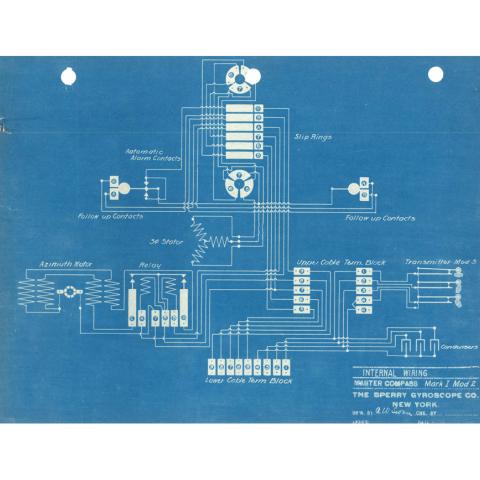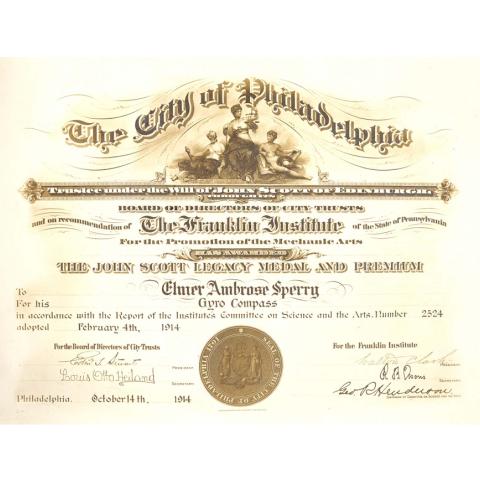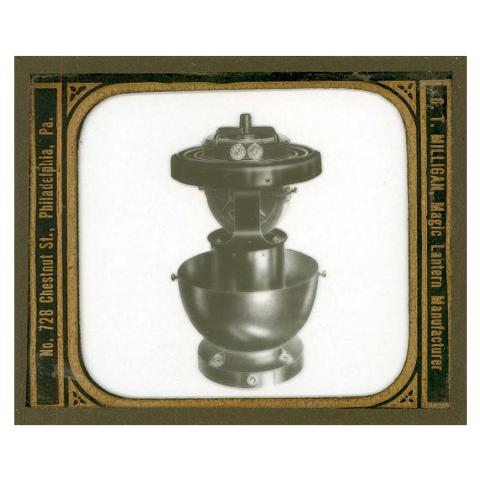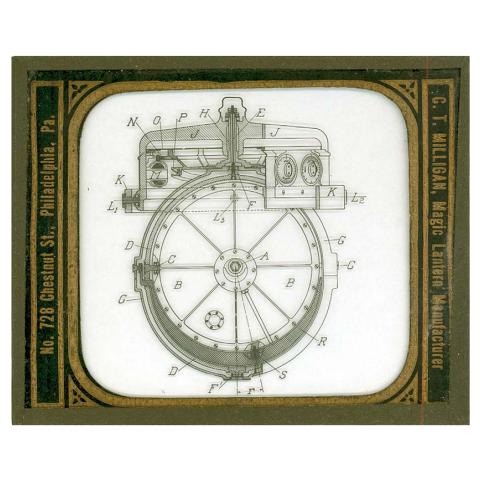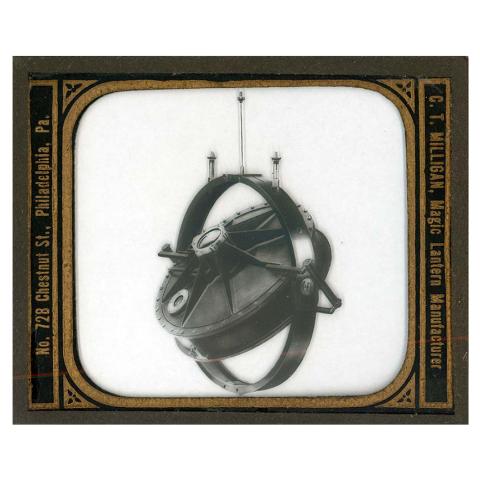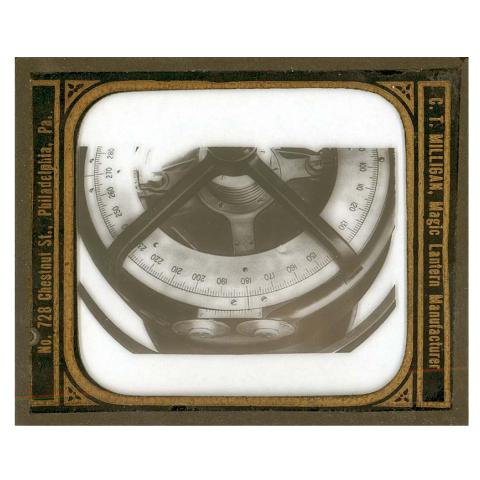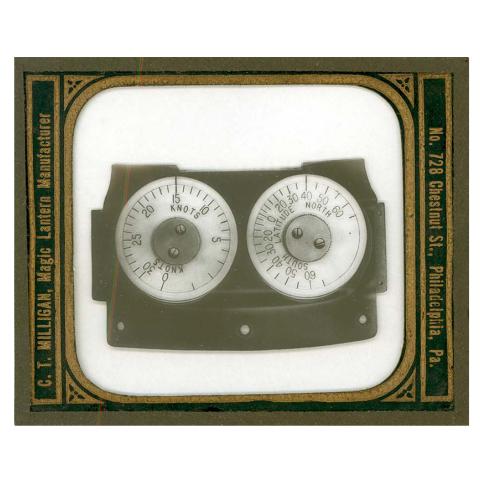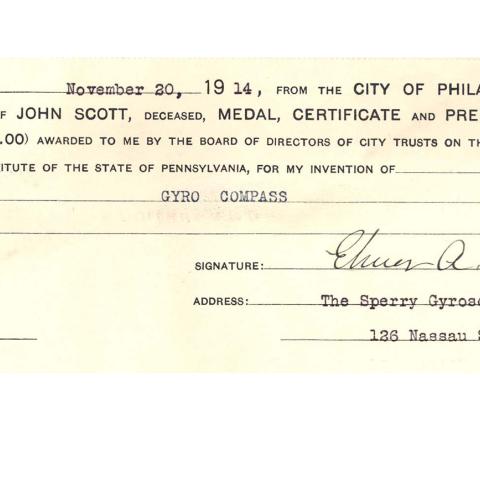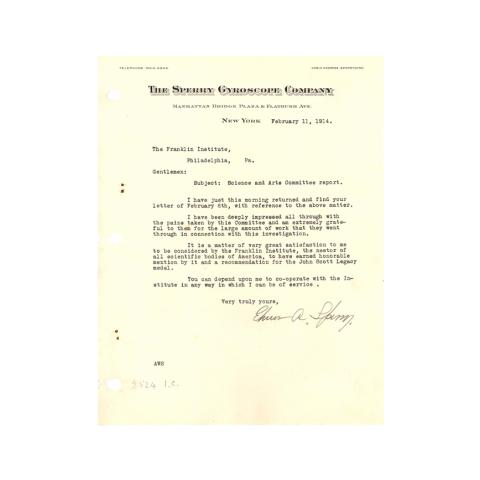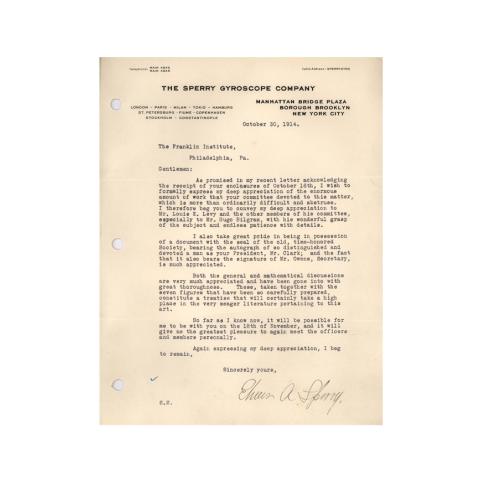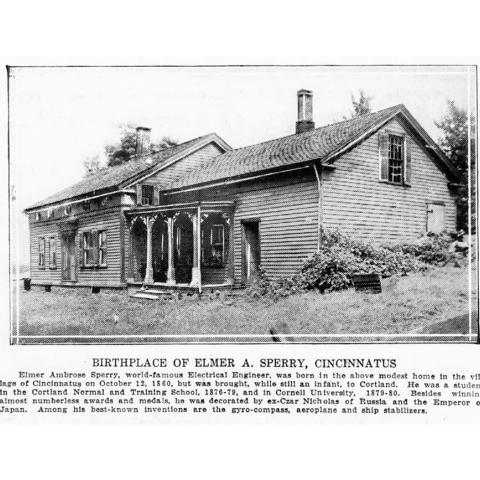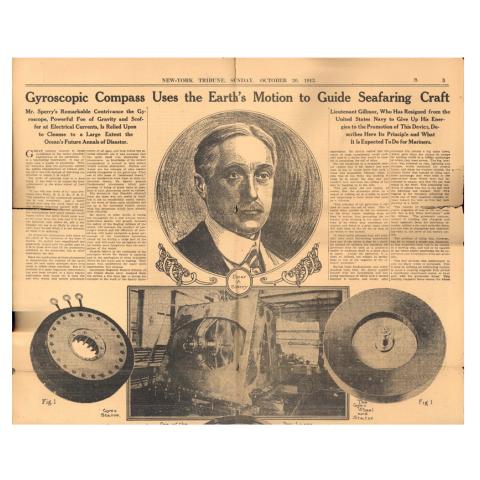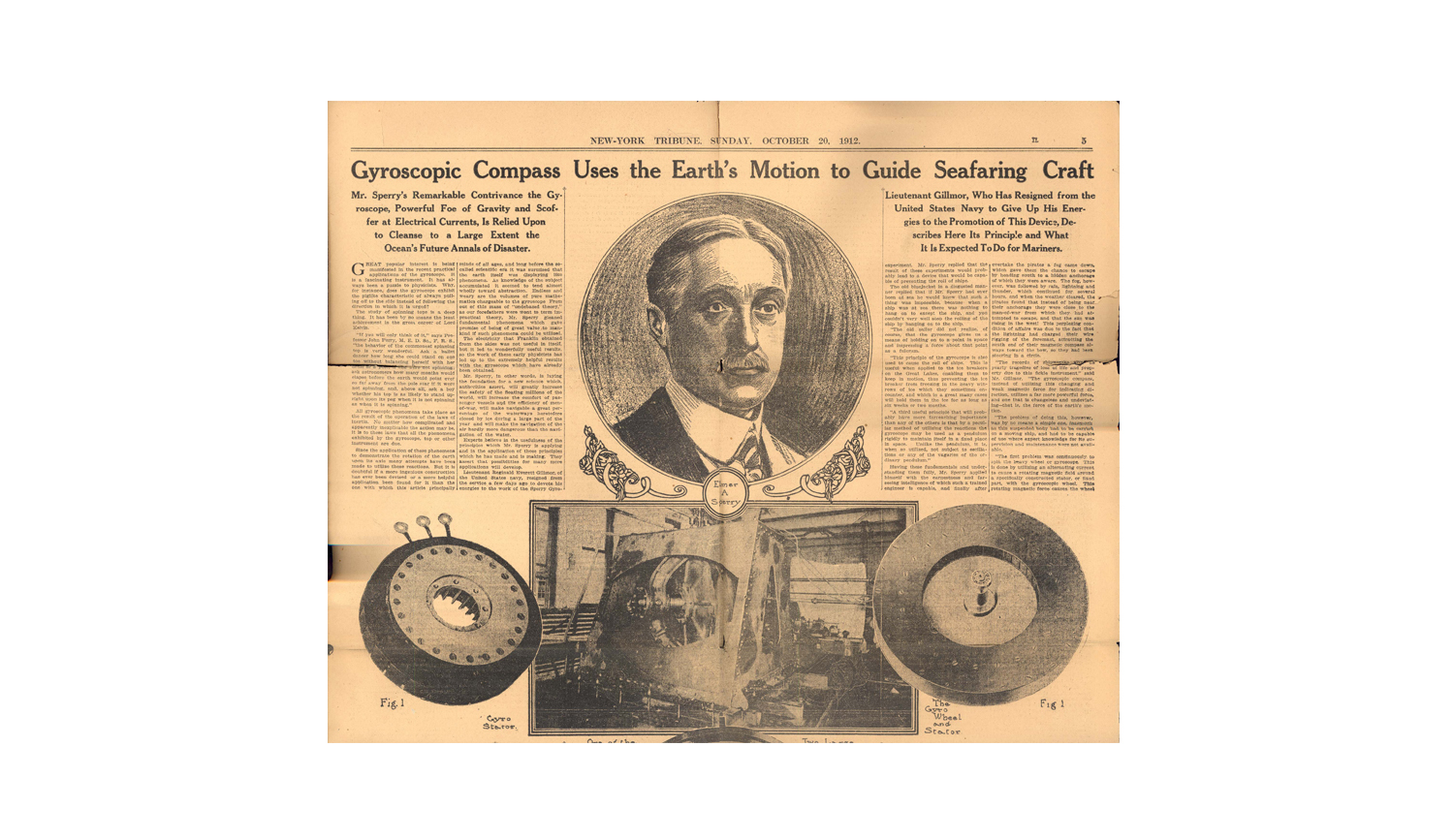
An old news article featuring Elmer A Sperry and his gyro-compass
Introduction
Who was Elmer Ambrose Sperry? What was the Gyroscopic Compass? How did the Sperry Electric Company begin? What is the legacy of Sperry, his science, and his rewards?
Finding True North
In the year 1913, the gyroscopic compass of up and coming inventor Elmer Ambrose Sperry caught the attention of The Franklin Institute. Submitted for evaluation by The Franklin Institute's Committee on Science and the Arts, the invention's application was met with such satisfactory remarks that it was recommended for receipt of the John Scott Legacy Medal and Premium. On the advice of The Franklin Institute, the city of Philadelphia honored Mr. Sperry with this award in October of 1914.
The Sperry gyroscopic compass evaluation, tucked into overstuffed folders on file in Franklin Institute archives, offers a glimpse into a 20th century world overwhelmed by invention. Inventor, engineer, and entrepreneur, Sperry's desire for technological advancement compelled him to acquire hundreds of patents and to found several companies. Sperry's spirit of innovation, coupled with his entrepreneurial drive, would leave a lasting impression on a world that seemed to turn faster as it encountered myriad advancements in both engineering and economics.
Humble Beginnings
Elmer Ambrose Sperry was born on October 21, 1860, in a small house in Cortland County, New York. His mother, Mary, died in childbirth, and his father, Stephen, was out of town working at the time of his birth. Sperry's grandparents and Aunt Helen became his primary caretakers. Before he was ten, Sperry moved with his grandparents to the more urban Cortland village, glad to leave behind the harsh winters and howling winds that stormed through the countryside of his youth. His time spent on the Sperry farm, however, gave young Elmer Ambrose his first hands-on experiences with technology. Most notable was his opportunity to study water-driven mills, afforded him by the close proximity of the Tioughnioga River. Inspired by what he saw, Sperry built small water wheels of excellent design, which he sold as toys. Already observable were engineering and economic skills that would be characteristic of the adult Sperry's success.
A Beautiful Mind
Sperry's schooling failed to endow him with a detailed knowledge of physics and chemistry; nevertheless, the inventor was able to grasp broad principles and apply those when solving technical problems. His mind was quick to isolate such problems, and upon recognition of a technical inadequacy his nimble fingers began to sketch out a solution.
Sperry's bookkeeper in Chicago spoke to the quality and quickness of the inventor's mind when he recalled: "I have many times seen him seemingly just looking into the air, when all at once he would pick up a pad and hold it at arms length, then with a pencil in the other hand he would begin to draw...I have heard it said that judging his activities compared to ordinary people, he had lived hundreds of years." Sperry had the capacity to sustain concentration over remarkable periods of time—his associates were consistently amazed at his ability to pick up technical conversations exactly where they had left off, even if their interruption had occurred days prior to their resumption. The inventor-engineer organized his time meticulously, determined to evade the possibility of idleness. To this end, he went so far as to redesign his slide rule so that it could be carried in his vest pocket at the end of his watch chain, available for use at all times.
His mind retained its inventive powers until he drew his last breaths: as he lay recovering from a slight stroke in an overheated Brooklyn hospital room he ordered ice placed in front of his electric fan, in order to generate cool breezes. His obituary, published in the June 17, 1930 edition of the New York Times, alludes to the mythological journey to the underworld across the river Styx, making mention of "Charon's ferry." The obituary proclaims: "he has left among men an everlasting fame, and imagination allows one to think of his inventive spirit making suggestions to the ferryman about improving service in the crossing for the benefit of those who have to take it later. For Mr. Sperry was ever thinking of how he might make the dwellers on earth a little more at ease whether on sea or land or in the air." The verity of this final testament is seen in the hundreds of patents issued to Sperry, and the lasting impression his inventions have left on the world of technology.
City Life
The years spanning 1870 to 1880 witnessed a decade of rapid industrialization for Cortland village. By early 1870, the use of roads and navigable rivers and the arrival of two major railroads (the Syracuse, Binghamton, & New York Railroad, and the Utica, Ithaca, & Elmira Railroad) connected the town with the rapidly expanding national economy. Sperry was captivated by the manufacturing and repair shops springing up around him. He observed with rapt attention the activity underway at the blacksmith shop, the machine shop, the foundry, the printing press, and the railway yard. Outside of his studies, he put in hours working at a machine shop, a foundry, and a book bindery. His local YMCA provided him with a library and a periodical reading room, at a time when public libraries were few and far between. Y-sponsored lectures and trips to technology exhibitions further impacted young Sperry.
His professors at the Cortland Normal School, too, played an important role in Sperry's formative years, especially those who worked with and encouraged the boy outside of the classroom. In general, he was not outstanding in the classroom setting. Sperry proved to be a good science student who displayed some strength in mathematics, though his skills in spelling were extremely lacking. He was a dynamic speaker, and at a time when he had become distinguished in his profession he remarked: "I can see that the whole world seemingly does not revolve around spelling." Though they failed to revolve around orthography, the revolutions of the earth would prove integral to the development of one of Sperry's most famous developments: the application of the gyroscope to ships, and later, airplanes.
Street Smarts
Sperry left the blooming town of Cortland for the bustling streets of Chicago in 1883. The young man tossed around numerous inventive ideas before choosing those most worthy of development. He based his decision on the amount of financial support he was able to accrue in the early development stages of his inventions. Applying for patents, constructing a prototype, and then facilitating testing were expensive processes, and Sperry's own capital was not sufficient to finance the research and development process. Once funded, Sperry was able to bring his inventive goals to fruition and to form companies that would manufacture and sell his products.
Chicago saw the founding of the Sperry Electric Light, Motor, and Car Brake Company, where Sperry would learn to develop his inventions to meet competition, and to survive in the economic market. He later moved to Brooklyn, New York, where he founded several companies, notably the Sperry Gyroscope Company in 1913. This company was named for the gyroscope, arguably Sperry's most famous invention. His first gyroscopic inventions were stabilizers for ships and automobiles, followed by the gyroscopic compass with which this case file concerns itself. However, before we explore the principle behind the latter invention, it will be necessary to discuss some of the ideas that contributed to the success of the former.
The Softer Side
A clever businessman and an ingenious inventor, Sperry's serious, scientific side was softened by a kind heart and a fulfilling family life. In his younger years, he found himself feeling lonely when not absorbed by his work; however, January 1885 brought the meeting of Sperry and Zula Goodman, and the end of Sperry's loneliness.
The young scientist spied Zula playing the organ at the First Baptist Church of Chicago, where he attended services. Her broad interests, love of music, and blue eyes attracted Sperry, and the two were married on June 28, 1887. They had four children: Helen (named for Sperry's aunt), Edward, Lawrence, and Elmer. Sperry's sons followed in his footsteps, striving to enhance technology.
Elmer Ambrose Jr. would also be recognized by The Franklin Institute, for his development of the Gyro-Pilot for ships. Both Edward and Elmer A. Junior joined the Gyroscope Company, and Lawrence Sperry took a special interest in air travel, founding the Lawrence Sperry Aircraft Company in 1918. Sadly, the young man died flying across the English Channel on December 13, 1924.
Sperry met with heartache again on March 11, 1930, when Zula passed away due to complications from pneumonia. He stayed with her and made sure that she died without pain. In the period following her death, he wrote to Zula's friends and relatives in the hope of collecting stories and sentiments about his wife. He intended to compile a commemorative book in her honor.
Her friends and relatives attested to Zula's kindness and gentility, just as Sperry's family and business comrades affirmed his good-natured character. In a "Profile" written on April 19, 1930, the New Yorker commented: "Although the traits of the inventor are strong in him, Sperry has none of the eccentricities common to the species. Had not an insatiable curiosity etched a kind of quizzical alertness on his face, he would have all the surface characteristics of the conventional successful American. He is well tailored. His white hair and mustache give the required distinction; but his eyebrows are permanently raised in blended wonder and pleasure."
Company History
Sperry founded his first company in 1880 in Chicago. The Sperry Electric Company manufactured the electric dynamos and arc lamps that Sperry had invented as a teenager. Over the next fifty years, Sperry's staggering number of inventions prompted him to found seven more companies for the sale and manufacture of his novel devices. Among these were Sperry Electric Mining Machine Company, Sperry Electric Railway Company, Chicago Fuse Wire Company, and Sperry Gyroscope Company.
The war in Europe created a demand for gyrocompasses that contributed significantly to the growth of Sperry Gyroscope. The Allied navies turned to Sperry with their need to equip both surface ships and submarines with the compass. As a result of these sales, Sperry Gyroscope expanded its facilities, as well as its profit. All of Sperry's companies eventually evolved into the Sperry Corporation. In 1955, Sperry Corporation acquired Remington Rand, an early American computer manufacturer. The company was briefly renamed "Sperry Rand," but in 1978 it decided to concentrate on its computing interests and reverted back to "Sperry Corporation."
In 1986, Sperry Corporation merged with Burroughs Corporation to form Unisys Corporation.
To View the Turning
The term "gyroscope" literally means "to view the turning." The mechanism itself consists of a spinning mass, such as a disk or a wheel, which is mounted on a base in a manner that enables its axis to turn in one or more directions. The axis is thus able to maintain its orientation regardless of any movement by the base.
In 1832, Professor W.R. Johnson devised such a mechanism in order to illustrate the dynamics of rotating bodies, calling his model a "rotascope." Twenty years later, in 1852, the French scientist Leon Foucault referred to the device as a "gyroscope" when he published an account of his experiments with the gyro. He used the gyro to show the rotation of the earth.
In 1851, he had used the pendulum to demonstrate this rotation, showing that the direction of a pendulum's swing will change as the earth rotates. When you set a pendulum swinging, it will continue to swing in the same direction unless—according to Newton's First Law—it is pushed or pulled in some other direction. As it swings, the earth will rotate once every twenty-four hours underneath the pendulum, causing its swing to appear to change direction. If you stood watching the pendulum, after about a quarter of an hour you would be likely to notice that the line of the pendulum's swing had changed to a different direction. This would be especially clear if you marked the position of the line of swing in the morning and had the pendulum knocking down pegs arranged in a ring around its trajectory.
Such an arrangement can be seen in the pendulum stairwell of The Franklin Institute. It is natural to conclude that the change in direction indicates movement on the part of the pendulum, and stability on the part of the floor. However, it is actually the floor (which is connected to the earth) that is moving as its own "base" (earth) rotates, while the line of swing of the pendulum only appears to rotate.
Degrees of Freedom
A gyro has two basic mountings: one with three degrees of freedom, and one with only two degrees of freedom. A gyro having three degrees of freedom is able to rotate about three axes including its own axis of rotation. Foucault used such a model to illustrate the rotation of the earth, crafting a model with a gyro mounted in two rings. One ring rotated on a horizontal axis within the other, which in turn rotated on a vertical axis.
Remember that the gyro itself is a spinning mass mounted on a base, and therefore has its own axis. Its center of gravity is located at the intersection of all three axes of rotation. Foucault rotated the wheel of the gyro using a string, and aligned as optical sighting device on the gyro wheel. Observers noted that, as time passed, the wheel seemed to move out of alignment with the optical sighting device. The case here is the same of that of the pendulum outlined above: the sighting device rotated with the earth while the gyro maintained its orientation in space during the few minutes the wheel rotated at high speed. Foucault was unable to sustain the spinning of his gyro wheel, but later inventors would add a motor that would surmount this problem.
Foucault went on to experiment with a gyro having two degrees of freedom, hypothesizing that such a gyro could be used as a compass. He limited the gyro's degrees of freedom to two by weighting the interior ring of the gyroscope, thereby restraining its freedom of rotation about the horizontal axis. Due to the weight, the gyro became pendulous, and felt the force of gravity. Foucault predicted this result, going on to say that the force of gravity would cause the gyroscope to precess until the axis of rotation of the spinning wheel was parallel to the axis of rotation of the earth. With an axis thus oriented, the gyroscope would be pointing to true north.
Again Foucault was hampered by his inability to keep the wheel spinning at a high speed, but the later addition of a motor would once more solve this problem. Now that we have discussed the meaning of a "degree of freedom," it will be necessary to tackle the tricky topic of precession. This phenomenon facilitates the function of the gyroscope.
Precession
Precession is the motion of the axis of a spinning body that results when there is an external force acting on that axis. The phenomenon finds its roots in the first law of Newtonian Physics, which states that a body in motion continues to move at a constant speed along a straight line unless it is acted upon by an outside, unbalanced force.
Precession was a concept basic to the invention of the gyrostabilizer, which Sperry initially created when he began his attempt to apply the gyro to useful purposes. He used this device to stabilize first automobiles, and later ships. He pointed out that rigidly mounted wheels did not stabilize automobiles, nor did rigidly mounted turbines succeed in reducing the roll of ships. Sperry explained that their rigid mountings prevented the wheels and turbines from moving in response to outside forces, and thus absorbing the disturbing energy of those outside forces. In short, the rigid mountings prevented the revolving masses from precessing. In explaining his devices, Sperry often had to define this concept of "precession." One of his clearest definitions went as follows:
"If I impress a force on one end of the axis of a gyroscope it will resist this impressed force but will turn in a direction at right angles to the force impressed. This motion at right angles to the impressed forces is called "precession." It will be observed that the gyroscope does not resist any forces impressed by linear motion; nothing but angular motion causes precession, and nothing but the forces impressed by angular motion are resisted. This angular motion may be about a point within the gyro or a point at any distance from the gyro, but must be angular motion."
Twists and Turns
The concept of precession and its accompanying definition seem rather complex, but if you think about an automobile and apply Sperry's words, an understanding of precession becomes a bit more accessible. Imagine a car driving along a straight, flat road. As it makes its way along this stretch of road, it is in linear motion, and its wheels are not angled in response to a force impressed by an angular motion. If, however, our car reaches a sloping section of road, that curves and climbs as it winds its way around the side of a mountain, its wheels will precess, or turn in response to the new angles of the road. If our car's wheels did not have the ability to do this, the car would run the risk of flipping over each time it encountered a part of the road that did not run straight. The concept of Sperry's automobile stabilizer enables automobiles to hug the road, and to remain upright as their wheels absorb the disturbing energy resulting from the twists and turns they encounter on the road.
For a more detailed description of precession, including diagrams and a video clip, see How Gyroscopes Work.
Laying Down the Law
Foucault's First Law
Based on what we know about "degrees of freedom," as well as precession, we are equipped with the information necessary to gain a basic understanding of Foucault's Laws. His first law states that any gyroscope possessing three degrees of freedom. That is, free to move in all three planes and unaffected by the force of gravity, must indicate the rotation of the earth. Foucault proved this law when he performed the experiment with the optical sighting device. As we know from our previous discussion, the gyroscope seemed to move out of alignment with the sighting device, though in actuality this "movement" resulted because the sighting device rotated with the earth while the gyro maintained its orientation in space.
Foucault's Second Law
Foucault's second law considers a gyroscope possessing only two degrees of freedom, stating that any such gyroscope will, at any place on earth's surface, other than the two poles, tend to set itself with its axis of rotation in the plane of the axis of the earth itself by reason of the relative rotation of the two bodies. As the gyro rotates, it will tend to maintain its plane of rotation in space, while the earth's continued turning will cause it to rotate "out from under" the gyro. Eventually the force of gravity acting on the gyroscope will cause it to precess, and the plane of its rotation will become more nearly coincident with that of the earth, thus limiting the tendency of the earth to rotate "out from under" the gyroscope.
These laws point to the use of the gyroscope as a compass. A gyroscope possessing three degrees of freedom could be used to fix lines in space with which bearings could be compared, or by which courses already known could be maintained. The gyroscope having two degrees of freedom would place itself in the plane of the earth's rotation, thus indicating the north and south mechanically by the position of its axis.
Isolating the Problem
Using the gyroscope as a compass indeed seemed an ingenious idea, but several problems presented themselves to Sperry and other inventors struggling to create compasses that incorporated the gyro. In a publication of U.S. Naval Proceedings these problems are outlined as follows:
- To suspend the gyro with perfect freedom about the vertical axis so that it is free to precess toward the meridian.
- To damp the oscillations of the gyro across the meridian so that it will quickly settle down with its axis north and south.
- To constantly impress just exactly the right degree of force to keep it precessing to follow the component of the earth's rotation, which is normal to the earth's surface.
- To drive the gyro at a high rate of speed in order to furnish the directive force required.
- The following problems would need to be solved if the compass were to be placed onboard a ship: To so suspend the gyro that forces of acceleration and deceleration introduced by movements of the ship will not cause it to oscillate off the meridian, making its readings incorrect. These forces of acceleration and deceleration introduced by the ship are:
- a.) Acceleration and deceleration arising from starting and stopping the ship and changing its speed.
- b.) Centrifugal forces introduced by the ship in turning.
- c.) Forces due to non-coincidence of the center of the gyroscope with the center of oscillation of the ship, that is, forces introduced by rolling and pitching of the ship.
- To correct the compass for deflection, due to northerly and southerly components of the ship's movement, which, of course, act on the compass just as the movement due to the earth's rotation, except, of course, in a very much less degree.
Heading in the Right Direction
In developing his compass, Sperry was aware of these problems. He knew that the performance of the pendulous gyro aboard a ship differed from the theoretical model, due to acceleration and deceleration on the part of this ship. As the ship changes speeds, changes course, rolls and pitches, it "confuses" the pendulous gyro.
The weight, which makes the gyro subject to gravity and results in its pendulous quality, cannot distinguish between gravity and the motions of the ship, causing the gyro to precess away from the meridian. The gyro instead attempts to align its spin axis with the axis that results from the combination of the earth's spin and the ship movements.
Sperry compensated for this by suspending a weight (called a bail) from a horizontal axis and connecting the gyro and the weight (or bail) by a loose connection. The loose connection allowed the gyro three degrees of freedom within its limits. When the gyro reached the limits of the loose connection its movement around the horizontal axis was effectively restrained, and it was reduced to two degrees of freedom. When on the meridian, the gyrocompass enjoyed three degrees of freedom, when it ventured toward or away from the meridian it was limited to two. Sperry said of his device:
"The important advantages of the pendulous gyro having but two degrees of freedom are retained in the present apparatus, and notably the tendency of the gyro always to seek the north."
Putting a Damper on Things
In order to compensate for movements of the ship that would cause the gyroscopic compass to deflect, Sperry produced an automatic correcting apparatus, which he incorporated into the structure of the compass. The apparatus compensated for and automatically entered the components of the deflection. These components are the meridianal element of the course, the speed upon such a course, and the latitude. The compensation for these components was done in strict proportion to their several magnitudes. The readings were thus held exactly upon the meridian, and oscillation was dampened. In order to keep the gyro constantly spinning, Sperry added an electric motor, inspired by the work he had done with electricity earlier in his career.
By the mid-1920s, Sperry was world famous for the applications of his gyroscope to ships, and also to airplanes. The Sperry Gyroscope Company he founded in Brooklyn supplied the world's navies with gyrocompasses, having earned a reputation for precision in manufacture, research and development.
Scores of articles were written to celebrate Sperry's inventions, and to explain their function to the public. Examine several such articles by clicking on the thumbnails at right. The first appeared in a 1912 edition of the New York Tribune; the others in a 1911 and 1913 Scientific AmericanSupplement.
Support Our Troops
"You see it is very necessary to leave magnetism entirely and to reach out and lay hold of some other equally prevalent field of force." - Elmer A. Sperry to John D. Rockefeller
The possibility of using the gyroscope as a compass came along at an opportune moment in America's history. With World War I being fought in Europe, the U.S. Navy was developing its ships in American waters.
In 1911, six years before America's entry into the war, Sperry began work on his gyrocompass. Unlike the gyrocompass, the magnetic compass currently in widespread use depended on the earth's lines of magnetic force. Correction tables allowed the navigator to compensate for error resulting from variation in these lines.
The hull of the wooden ship did not interfere with the operation of the magnetic compass, but the advent of the iron and steel ship indeed posed a problem for that device. The metal components of this new variety of ship did shield the compass from the earth's lines of force and created a false magnetic field that the compass could not distinguish from that of the earth. The consequence of magnetic compass errors became increasingly more severe as navies added guns and firing power to their ships. In order for these weapons to be effective, it was essential that compasses onboard naval ships provide accurate readings.
Essential, too, was the presence of accurate compasses on-board submarines. The need to equip submarines with such a compass resulted in the development of the first gyrocompass. Its inventor was not Sperry, but a German scientist named Dr. Hermann Franz Joseph Hubertus Maria Anschutz-Kaempfe. Dr. Anschutz-Kaempfe began work on this device in 1906, after beginning development of a guidance device in 1902. His work had been aimed at his own personal goal of using a submarine to reach the North Pole, but his development of the gyrocompass won the support and encouragement of the German navy in 1906. The gyrocompass's successful tests in 1908 attracted the attention of Sperry, who decided that he would attempt to improve upon Anshutz-Kaempfe's design.
Coming into Conflict
A perusal of the documents contained in Sperry's case file brings to light a dispute over the originality of the design for his compass. Sperry champions the integrity of his original, insisting that he has improved upon other attempts made to fashion such a compass. Such improvement is the hallmark of Sperry's work. Speaking on his "inventive technique," the inventor revealed that his method entailed pinpointing the weaknesses of other inventions, and then working out ways to overcome those weaknesses. The clever inventor would point out:
"Necessity is the mother of invention, so the reverse would also seem to be true, each development in science and engineering necessitating the development of some device or devices to increase the efficiency of the prime development."
In response to a letter sent from the Franklin Institute on May 18, 1914, Anschutz-Kaempfe's German company challenged the originality of Sperry's "improvements" on the gyrocompass. In the company's letter of June 18, 1914, the Anschutz company denies that Sperry's methods of suspension and of damping oscillations resulting from outside forces are "special improvements."
The John Scott Legacy Medal
A Scottish chemist named John Scott bequeathed the sum of $4,000.00 in funded 3% interest stock of the United States to the corporation of the city of Philadelphia. His will, written in the year 1816, stipulated that interest and dividends yielded by this stock were to be distributed in the form of premiums to men and women judged to have come up with ingenious inventions.
Each premium was not to exceed the amount of $20.00, and was to be rewarded along with a copper medal bearing the inscription, "To the most deserving." The Select and Common Councils of the city of Philadelphia passed an ordinance in February of 1834 that vested the award of the premium and medals in The Franklin Institute. In 1869, administration of the John Scott Legacy Premium and Medal was conferred on the "Board of Directors of City Trusts," which in turn referred control of the aforementioned award to its own Committee on Wills' Hospital and Minor Trusts.
April of 1882 saw a resolution made by this Committee to "favorably receive the names of any persons whom The Franklin Institute may, from time to time, report to the Committee on Minor Trusts as worthy of receiving the John Scott Legacy Medal and Premium." Having accepted the above resolution, The Franklin Institute put its Committee on Science and the Arts in charge of making the necessary evaluations and recommendations.
Committee on Science and the Arts
In 1914, The Franklin Institute recognized the unique design and excellent function of Sperry's gyrocompass with a John Scott Legacy Medal. This particular medal was presented by the City of Philadelphia, based on the advice of The Franklin Institute's Committee on Science and the Arts (CSA). Appointed in 1824, the FI's advising committee was originally called the "Board of Examiners." For a brief time the appellation was changed to "The Committee on Inventions," and since 1834 the group has been referred to as "The Committee on Science and the Arts." This group was formed by The Franklin Institute's Board of Managers in response to "the need felt by inventors and discoverers, for some competent, trustworthy and impartial body, on whom they could confidently rely for an opinion as to the usefulness of their inventions and discoveries." The CSA provided this service through the examination and evaluation of inventions proffered during America's age of industrial revolution, a time when the U.S. Patent Office was neither as well-organized nor as well-functioning as it is today.
At this point in history, The Franklin Institute judged that the investigation and encouragement of new technology was vital to the growth of the nation. Accordingly, its Committee on Science and the Arts approved, disproved, or offered advice concerning the improvement of a given invention. In special cases, the CSA honored the inventor or improver of technology with an award or premium in acknowledgement of his contribution to "the Mechanical and Useful Arts."
Each invention undergoing evaluation by The Franklin Institute's Committee on Science and the Arts was given a case file, where documents prevalent to the study of that invention were kept. The Sperry case file, pulled from Franklin Institute archives, records primarily the exchange of letters between CSA Chairman Hugo Bilgram and Sperry himself. Their extensive correspondence was prompted by an objection, on the part of German inventor Anschutz-Kaempfe's company, to the originality of Sperry's invention. Anschutz-Kaempfe does have a distinctive voice in the case, although that voice is eventually drowned out by CSA investigations that reveal the credibility of Sperry's claim to having created a unique gyrocompass.
Sticking to the Rules
The Committee on Science and the Arts took care to compile a report on each invention or improvement its committee members judged worthy of the premium and accompanying medal. That report was then published three times in the Journal of The Franklin Institute, with the first publication occurring three months before the Committee would make an official recommendation to the Council on Minority Trusts. These publications allowed the public to review the inventions, and to raise objections as to their originality. If no such objections were made, the Secretary of The Franklin Institute certified the recommendation of the award to the Committee on Minor Trusts of the Board of City Trusts. You can access the full set of rules outlined by the Committee on Science and the Arts in its founding year by clicking on the links to the rules below. Digitalized documents pulled from the Sperry case file illustrate the process that resulted in his receipt of the John Scott Legacy Medal.
Sticking to the Rules: Rule 1
A recommendation for an award of the premium and medal shall be made only by the Committee on Science and the Arts, on a report of a sub-committee which shall have been appointed to examine such invention.
The thumbnail at top left is a letter from Sperry, agreeing to attend a meeting at The Franklin Institute. The thumbnail at top right is a letter written from Sperry to the Committee on Science and the Arts, sent in hopes of amending his original application for the evaluation of his gyrocompass.
The letters below and at right were written from CSA chairman Hugo Bligram to Sperry himself, and to fellow CSA committee member Professor Barnes, in an attempt to clarify his understanding of the workings of Sperry's gyrocompass. Sperry's responses are also featured.
Sticking to the Rules: Rule 2
The invention or improvement to be examined shall be accompanied by a clear description and drawings of the same, together with a model, if required, and also a statement on the particulars of the inventor's claim to originality.
Sticking to the Rules: Rule 3
When the invention is a composition of matter, specimens of the ingredients and of the compound sufficient for the purpose of experiments, and to preserve in the cabinet of the Franklin Institute, shall be furnished by the inventor.
View the lantern slides used to aid in examination of Sperry's gyrocompass. The last image is a circuit blueprint of Sperry's invention.
Sticking to the Rules: Rule 4
Upon adoption by the Committee on Science and the Arts of a report setting forth that an invention or improvement is worthy of an award of the premium and medal, publication shall be made three times in the Journal of The Franklin Institute, stating that at the expiration of three months from the date of the first publication, the Committee on Science and the Arts will recommend to the Committee on Minor Trusts of the Board of the City of Trusts, the award of the said premium and medal to the inventor, unless within that time satisfactory evidence shall have been submitted to the Committee on Science and the Arts of the want of originality of the supposed invention and improvement. In case no such objections to the final award of the premium and medal shall have been made, the Secretary shall certify the recommendation of the award to the Committee on Minor Trusts of the Board of City Trusts.
Above left: a letter from the Assistant to the Secretary of the Institute, informing Sperry of his recommendation for receipt of the John Scott Medal, and also of the requisite three month trial period of publication in the Institute's Journal. Above right: Sperry's response, in which he praises The Franklin Institute and pledges to "cooperate with the Institute in any way in which I can be of service."
Sticking to the Rules: Rule 5
All applications for the John Scott Legacy Premium and Medal must be made to the Secretary of the Institute, by whom the applications and accompanying descriptions, drawings, etc., shall be laid before the Committee on Science and the Arts, and by whom all publications ordered by said committee, in relation to said premiums and medals, shall be made.
Patents
In the Sperry case file, there are several documents attesting to a squabble over patents for the application of the gyrocompass to ships. Sperry obtained patents for his gyrocompass first in England, and later in the United States. In England, he was met with opposition by Anschutz-Kaempfe, though he did succeed in acquiring patents in London. Anschutz-Kaempfe was in possession of U.S. patents before Sperry himself acquired the same.
Read the Committee on Science and the Arts Report on Elmer A. Sperry’s Gyroscopic Compass.


